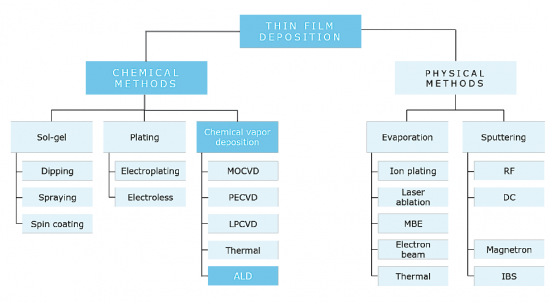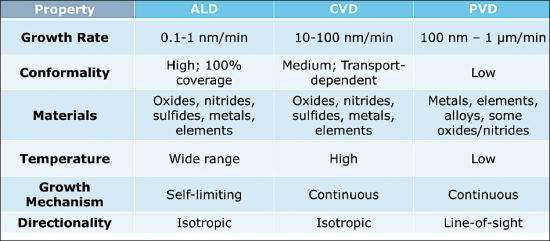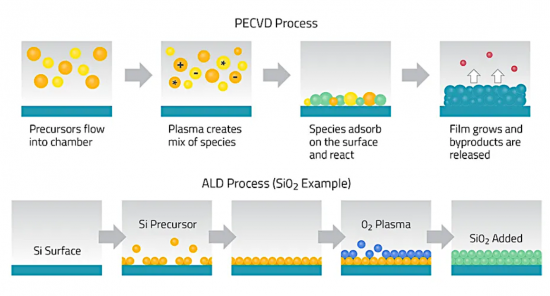 |
市场调查报告书
商品编码
1479764
薄膜形成:趋势、关键问题与市场分析Thin Film Deposition: Trends, Key Issues, Market Analysis |
||||||
简介
在半导体工业中,薄膜形成在电子元件的製造过程中发挥重要作用,它提供了在半导体基板上形成精确且受控的材料薄层的方法。 几个值得注意的趋势正在塑造半导体薄膜形成市场,反映了技术进步、不断变化的行业要求和新应用。
首先,对提供高产量、均匀性和可扩展性的薄膜形成技术的需求不断增长。 随着半导体装置变得越来越复杂和集成,製造商需要能够扩展到更大的基板尺寸并在整个表面积上实现一致的薄膜特性的沉积方法。 这一趋势正在推动原子层沉积 (ALD) 和化学气相沉积 (CVD) 等创新薄膜沉积製程的发展,这些製程可实现大批量生产,同时可以精确控制薄膜厚度和成分。

半导体薄膜形成市场的另一个趋势是越来越多地采用先进材料进行薄膜形成。 随着装置性能要求的不断提高,对具有导电性、光学透明度和热稳定性等客製化特性的薄膜的需求不断增长。 这一趋势正在推动专注于探索新材料的研发工作,以满足下一代电子设备不断变化的需求。
此外,人们对支援三维 (3D) 半导体结构和异构整合平台製造的薄膜形成技术越来越感兴趣。 随着 3D IC 和系统单晶片 (SoC) 架构等技术的出现,对能够在非平面表面上形成薄膜并实现精确的层间对准的沉积方法的需求不断增长。
此外,有一种趋势是将薄膜形成技术与原位监测和控制功能相结合,从而实现即时製程优化和缺陷检测。 透过将先进的计量工具和回馈机制整合到沉积系统中,製造商可以提高製程稳定性、产量和可重复性,并降低半导体设备的生产成本和上市时间。
总体而言,半导体薄膜形成市场的趋势凸显了该行业对创新解决方案的持续探索,以实现具有卓越性能、功能和可靠性的先进电子设备的生产。 随着半导体技术的不断发展,薄膜形成仍然是推动半导体产业进步和创新的关键技术。
薄膜沉积技术的趋势
半导体薄膜形成技术的趋势特征是精度更高、材料多样性、设备复杂性、环境永续性和製程智慧化。 这些趋势正在塑造新沉积方法和材料的发展,推动半导体产业朝向具有前所未有的性能和功能的下一代电子产品发展。
由于电子元件不断追求小型化、性能提高和成本效率,半导体薄膜形成技术的情况正在发生重大变化。 这种演变的特点是几个重要趋势,反映了半导体产业不断变化的需求以及旨在满足这些需求的技术创新。
原子层沉积 (ALD) 等技术越来越受到关注,因为它们可以一次沉积一个原子层,从而可以对薄膜厚度和成分进行无与伦比的控制。 这种精度对于製造下一代半导体设备至关重要,即使很小的偏差也会对设备性能产生重大影响。 ALD 保形沉积复杂 3D 结构的能力对于 3D 积体电路 (IC) 和先进储存技术等先进应用至关重要。

传统的硅基半导体正在被各种新材料增强或取代,例如高 k 电介质、金属氧化物以及石墨烯和过渡金属二硫属化物等二维 (2D) 材料。 这些材料具有优异的电气、热和机械性能,有助于开发更高性能和更低功耗的设备。 结合这些材料需要沉积技术的进步,以解决其独特的性能和整合课题。
本报告研究和分析了全球半导体市场,并对薄膜沉积技术的现状进行了展望。 它还确定了研究重点、等待解决的技术课题以及预期的市场变化。
目录
第一章简介
第 2 章执行摘要
第 3 章物理气相沉积
- 简介
- 溅镀技术
- 等离子技术
- 反应器设计
- 半导体工艺
- 目标
第 4 章化学气相沉积
- 简介
- 化学气相沉积(CVD)技术
- APCVD
- LPCVD
- 等离子CVD
- HDPCVD
- 阿尔达
第五章电化学沉积
- 简介
- 反应器设计
- 作业
- 添加剂
- 处理中
- 铜阴极
- 湿铜种子层
第六章成膜与薄膜特性
- 简介
- 介电膜形成
- 金属沉积
第 7 章供应商问题
- 简介
- 450mm加工
- 整合处理
- 铜
- 测量
- 静电放电
- 参数测试
第八章市场预测
- 简介
- 主要问题
- 市场预测的假设
- 市场预测
- 化学气相沉积
- 物理气相沉积
- 电镀铜市场
- ALD 市场
Introduction
In the semiconductor industry, thin film deposition plays a crucial role in the manufacturing process of electronic devices, providing a method to deposit thin layers of materials onto semiconductor substrates with precision and control. Several notable trends are shaping the semiconductor thin film deposition markets, reflecting advancements in technology, evolving industry requirements, and emerging applications.
Firstly, there is a growing demand for thin film deposition techniques that offer high throughput, uniformity, and scalability. As semiconductor devices become increasingly complex and integrated, manufacturers require deposition methods that can accommodate larger substrate sizes and deliver consistent film properties across the entire surface area. This trend is driving the development of innovative deposition processes, such as atomic layer deposition (ALD) and chemical vapor deposition (CVD), which offer precise control over film thickness and composition while enabling high-volume production.

Another trend in the semiconductor thin film deposition markets is the increasing adoption of advanced materials for thin film deposition. As device performance requirements continue to escalate, there is a growing need for thin films with tailored properties, such as enhanced electrical conductivity, optical transparency, and thermal stability. This trend is driving research and development efforts focused on exploring new materials to meet the evolving demands of next-generation electronic devices.
Furthermore, there is a rising emphasis on thin film deposition techniques that support the fabrication of three-dimensional (3D) semiconductor structures and heterogeneous integration platforms. With the advent of technologies like 3D ICs and system-on-chip (SoC) architectures, there is a growing need for deposition methods capable of depositing thin films on non-planar surfaces and achieving precise layer-to-layer alignment.
Moreover, there is a trend towards the integration of thin film deposition techniques with insitu monitoring and control capabilities, enabling real-time process optimization and defect detection. By incorporating advanced metrology tools and feedback mechanisms into deposition systems, manufacturers can enhance process stability, yield, and reproducibility, thereby reducing production costs and time-to-market for semiconductor devices.
Overall, the trends in the semiconductor thin film deposition markets underscore the industry's ongoing quest for innovative solutions that enable the fabrication of advanced electronic devices with superior performance, functionality, and reliability. As semiconductor technologies continue to evolve, thin film deposition will remain a critical enabling technology, driving progress and innovation in the semiconductor industry.
Trends in Deposition Technology
The trends in semiconductor thin film deposition technology are characterized by a move towards greater precision, material diversity, device complexity, environmental sustainability, and process intelligence. These trends are shaping the development of new deposition methods and materials, driving the semiconductor industry towards the next generation of electronic devices with unprecedented performance and functionality.
The landscape of semiconductor thin film deposition technology is undergoing significant transformation, driven by the relentless pursuit of miniaturization, enhanced performance, and cost-efficiency in electronic devices. This evolution is marked by several key trends that reflect the changing demands of the semiconductor industry and the technological innovations designed to meet these needs.
A pivotal trend is the shift towards atomic precision in thin film deposition processes. Techniques such as Atomic Layer Deposition (ALD) are gaining prominence for their ability to deposit films one atomic layer at a time, offering unparalleled control over film thickness and composition. This precision is crucial for manufacturing the next generation of semiconductor devices, where even minor deviations can significantly impact device performance. ALD's ability to conformally coat complex 3D structures makes it indispensable for advanced applications, including 3D integrated circuits (ICs) and advanced memory technologies.

Another significant trend is the diversification of materials used in thin film deposition. Traditional silicon-based semiconductors are being augmented or replaced by a variety of new materials, including high-k dielectrics, metal oxides, and two-dimensional (2D) materials like graphene and transition metal dichalcogenides. These materials offer superior electrical, thermal, and mechanical properties, enabling the development of devices with higher performance and lower power consumption. The incorporation of these materials necessitates advancements in deposition technologies that can handle their unique properties and integration challenges.
The push for greater device integration and functionality is driving the adoption of complex multi-layer structures, which require sophisticated deposition techniques capable of delivering high-quality films with strict interlayer interfaces and uniformity. As devices shrink and the number of layers increases, deposition technologies must offer excellent control over interface engineering, stress management, and layer uniformity to ensure device reliability and performance.
Environmental sustainability and energy efficiency are also becoming critical considerations in thin film deposition processes. The semiconductor industry is increasingly focused on reducing the environmental footprint of manufacturing processes, leading to the development of deposition techniques that consume less energy, use fewer hazardous chemicals, and generate less waste. This trend is not only driven by regulatory pressures but also by the industry's recognition of the importance of sustainable practices for long-term viability.
Lastly, the integration of in-situ monitoring and analytics with deposition processes is a growing trend. Advanced sensors and data analytics are being incorporated directly into deposition systems, enabling real-time process control and optimization. This integration enhances process repeatability, improves yield, and reduces the need for post-deposition inspection, thereby lowering manufacturing costs and improving device performance.
The Need for This Report
This comprehensive semiconductor deposition report provides an in-depth exploration into the multifaceted domain of deposition technologies pivotal to semiconductor manufacturing. It begins with a foundational overview of thin film deposition, shedding light on critical processes such as physical vapor deposition (PVD), chemical vapor deposition (CVD), atomic layer deposition (ALD), and molecular beam epitaxy (MBE). This section demystifies the principles behind each method, offering a comparative analysis to aid in understanding their unique benefits, limitations, and suitability for various semiconductor applications.
Delving into market dynamics, the report presents a detailed examination of global and regional trends, highlighting market growth, demand patterns, and future projections. It paints a comprehensive picture of the competitive landscape, identifying key players, their market positioning, strategic initiatives, and technological breakthroughs. Furthermore, it discusses the impact of regulatory frameworks and environmental standards on deposition practices, emphasizing the industry's response to sustainability and safety mandates.
Technological advancements occupy a central role in the report, showcasing the latest innovations that enhance film quality, deposition efficiency, and material diversity. It highlights the advent of new materials like 2D materials, high-k dielectrics, and metal oxides that promise to revolutionize semiconductor device performance. The narrative extends to the challenges of integrating these advanced deposition processes into mainstream manufacturing, addressing scalability, quality control, and cost-effectiveness.
The application of deposition technologies in fabricating cutting-edge electronic devices is thoroughly analyzed. This includes their role in developing logic chips, memory devices, power electronics, and their contribution to emerging sectors like 3D integrated circuits (ICs), flexible electronics, and solar cells. The report ventures into the future, speculating on the direction of research and development efforts aimed at overcoming existing technological hurdles, enhancing process capabilities, and discovering environmentally friendly deposition methods.
In its concluding sections, the report provides a forward-looking perspective on the deposition technology landscape, identifying research priorities, technological challenges awaiting resolution, and anticipated market shifts. It features case studies and expert opinions to ground its predictions in real-world examples and authoritative insights, offering readers a wellrounded understanding of the current state and future potential of semiconductor deposition technologies.
By weaving together these diverse strands of information, the report serves as a valuable resource for stakeholders across the semiconductor industry spectrum, from manufacturers and researchers to policymakers and investors, equipping them with the knowledge to navigate the complexities of semiconductor deposition in an era of rapid technological change.
About this Report
Thin film deposition processes play a critical role in the production of high-density, highperformance microelectronic products. Considerable progress has been achieved in the development of deposition processes -- and in the development of the reactor systems in which they are carried out. This report discusses relevant mechanisms; processing, system, and materials aspects, potential advances, and considerations regarding extendibility to a wafer diameter of 300 mm and beyond.
With the introduction of new thin-film materials to consistently shrinking microelectronic devices and circuits, and as the aperture ratio of an integrated-circuit structure increases, conformal step coverage becomes increasingly difficult to achieve. This report compares some of the issues impacting users of different deposition tools, including:
|
|
|

In addition, as device geometries shrink, semiconductor manufacturing has become increasingly complex and precise, requiring a better understanding of the specific processes involved. These issues are described in the report.
This report discusses the technology trends, products, applications, and suppliers of materials and equipment. It also gives insights to suppliers for future user needs and should assist them in long range planning, new product development and product improvement. A market forecast for Thin Film Deposition Tools is presented including market shares by deposition type between 2012 and 2023.
Table of Contents
Chapter 1. Introduction
Chapter 2. Executive Summary
Chapter 3. Physical Vapor Deposition
- 3.1. Introduction
- 3.2. Sputtering Technology
- 3.3. Plasma Technology
- 3.4. Reactor Designs
- 3.4.1. Long-Throw Deposition
- 3.4.2. Collimated Sputter Deposition
- 3.4.3. Showerhead Deposition
- 3.4.4. Ionized PVD
- 3.5. Semiconductor Processing
- 3.5.1. Feature Patterning
- 3.5.2. Gap Fill
- 3.6. Targets
Chapter 4. Chemical Vapor Deposition
- 4.1. Introduction
- 4.2. Chemical Vapor Deposition (CVD) Techniques
- 4.2.1. APCVD
- 4.2.2. LPCVD
- 4.2.3. PECVD
- 4.2.4. HDPCVD
- 4.2.5. ALD
Chapter 5. Electrochemical Deposition
- 5.1. Introduction
- 5.2. Reactor Design
- 5.3. Challenges
- 5.4. Additives
- 5.5. Processing
- 5.5.1. Superfilling
- 5.5.2. Aspect Ratios
- 5.6. Copper Cathodes
- 5.7. Wet Copper Seed-Layer
Chapter 6. Film Deposition And Film Properties
- 6.1. Introduction
- 6.2. Dielectric Deposition
- 6.2.1. Silicon Dioxide
- 6.2.1.1. Thermal CVD
- 6.2.1.2. PECVD
- 6.2.1.3. HDPCVD
- 6.2.2. Silicon Nitride
- 6.2.2.1. Thermal CVD
- 6.2.2.2. PECVD
- 6.2.2.3. HDPCVD
- 6.2.3. High-K Dielectrics
- 6.2.4. Low-K Dielectrics
- 6.2.1. Silicon Dioxide
- 6.3. Metal Deposition
- 6.3.1. Aluminum
- 6.3.2. Tungsten/Tungsten Silicide
- 6.3.3. Titanium Nitride
Chapter 7. Vendor Issues
- 7.1. Introduction
- 7.2 450mm Processing
- 7.3. Integrated Processing
- 7.4. Copper
- 7.5. Metrology
- 7.6. ESD
- 7.7. Parametric Test
Chapter 8. Market Forecast
- 8.1. Introduction
- 8.2. Key Issues
- 8.3. Market Forecast Assumptions
- 8.4. Market Forecast
- 8.4.1. Chemical Vapor Deposition
- 8.4.2. Physical Vapor Deposition
- 8.4.3. Copper Electroplating Market
- 8.4.4. Atomic Layer Deposition Market
List of Figures
- 3.1. Schematic Of Sputtering System
- 3.2. Magnetron Sputtering Design
- 3.3. Showerhead Reactor Design
- 3.4. Ionized PVD
- 4.1. APCVD Reactor
- 4.2. Tube CVD Reactor
- 4.3. HDPCVD Reactor
- 4.4. ALD Versus PVD Copper Barrier
- 5.1. Copper Electroplating System
- 7.1. Comparison Between Semiconductor and Equipment Revenues
- 8.1. Worldwide MCVD Market Shares
- 8.2. Worldwide DCVD Market Shares
- 8.3. Worldwide DCVD Market By Sectors
- 8.4. Worldwide HDHCVD Market Shares
- 8.5. Worldwide PECVD Market Shares
- 8.6. Worldwide SACVD Market Shares
- 8.7. Worldwide LPCVD Market Shares
- 8.8. Worldwide PVD Market Shares
- 8.9. Worldwide ECD Market Shares
- 8.10. Worldwide ALD Market Shares
List of Tables
- 8.1. Worldwide CVD Market Forecast
- 8.2. Worldwide MCVD Market Shares
- 8.3. Worldwide DCVD Market Shares
- 8.4. Worldwide HDPCVD Market Forecast
- 8.5. Worldwide HDPCVD Market Shares
- 8.6. Worldwide PECVD Market Forecast
- 8.7. Worldwide PECVD Market Shares
- 8.8. Worldwide SACVD Market Forecast
- 8.9. Worldwide SACVD Market Shares
- 8.10. Worldwide LPCVD Market Forecast
- 8.11. Worldwide LPCVD Market Shares
- 8.12. Worldwide PVD Market Forecast
- 8.13. Worldwide PVD Market Shares
- 8.14. Worldwide ECD Market Forecast
- 8.15. Worldwide ALD Market Forecast









